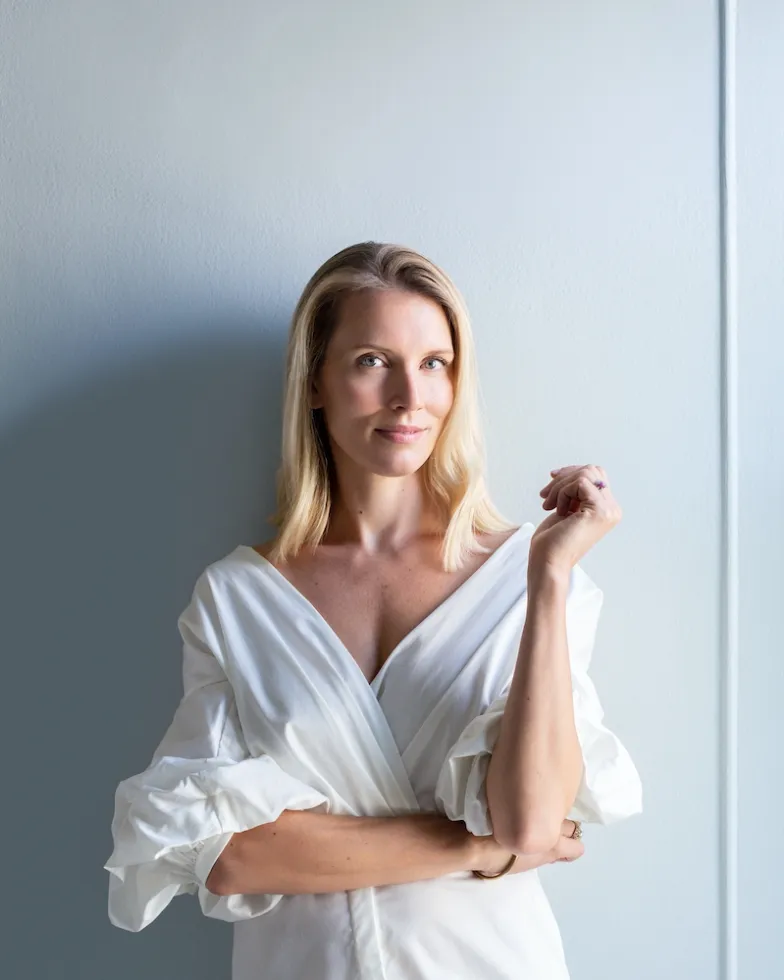Interior Design
In Conversation Wth Kate Reynolds
In this month’s edition of In Conversation With, we sat down with Kate Reynolds, founder of the renowned New York design studio Temple. Temple represents a curated selection of textile designers and artists from around the world, including The Collection by Salvesen Graham.

Textile Expert
Can you tell us about the design behind your lovely new showroom?
The biggest challenge in curating a multi line showroom is figuring out how to make all the different lines talk to each other. I love hosting dinner parties and inviting guests from different walks of life. It's fun to watch strangers mingle and learn about each other. I take the same approach to how we display collections in our showroom. There are some vignettes that allow you to shop by color, others are there to inspire with creative wow factor, and then we of course also have collections separated by artist too.Creating this showroom was also a bit of a nostalgic journey for me. remember flipping through in my childhood. It’s a charming, tactile experience that brings a little bit of the past into the present and makes exploring patterns feel special and intentional.
Can you tell us about a design book, exhibition, or experience that fundamentally changed how you see textiles?
I’m fascinated by the blend of art, science, and math that goes into creating textiles. The structure of a weave, for example, is like a mathematical puzzle, and that complexity always amazes me. It’s similar to walking through an old city and marveling at the architecture—some of those designs would be nearly impossible to recreate today, whether because of the materials, the time, or the craftsmanship involved.I find myself most inspired when I’m traveling or visiting museums and seeing how different cultures have used textiles throughout history. Some are incredibly intricate, while others are beautifully simple, and that contrast keeps me in awe. The Metropolitan Museum of Art is always an endless trove of inspiration! I was also blown away by all of the pattern and color combinations I saw on a visit to Thorvaldsens museum in Copenhagen last summer.
Can you tell us about how the relationship with Salvesen Graham came about and how the collection is received by your US customers?
I’ve been a fan of Mary and Nicole’s design work for quite some time, and I absolutely love the sense of comfort they bring into their spaces.What really stands out to me is how thoughtfully Mary and Nicole have approached their designs. They’ve really taken the time to identify what they need more of in their own design projects, and that insight translates into a collection that feels both inspired and practical. The colors have a richness and depth to them, so rather than just one flat tone, you get these beautiful blends that complement a wide variety of palettes. Our clients have really embraced the collection, and it’s always a joy to see how seamlessly these textiles fit into their projects.
Can you tell us about your journey before Temple Studio - what experiences shaped your approach to textiles and design?
Growing up with an interior designer for a mom meant that my childhood was filled with visits to workshops, galleries, and studios as well as larger design showrooms. That early exposure to creative work really opened my eyes to the beauty and the stories behind each piece. I've always been drawn to artisans and the unique perspectives they bring to their crafts.When I began my career in the New York City textile showroom industry in the early 2000s, I had the opportunity to work with showrooms that represented these smaller, boutique collections. This was a shift from the large brand-name showrooms I remembered from my childhood, where the focus was more on the product than the story behind it. In the early 2000s, there was this exciting emergence of artists who wanted to tell a story through their work, and that really resonated.
How has the design industry's approach to textiles changed since you founded Temple Studio?
I would definitely say the advances in digital printing are coming to mind. When digital printing first became an option to textile designers, there was this initial burst of excitement—almost like, ‘We can print anything now!’ And sometimes it felt like they did… with mixed results. But the craft has matured. These days, the best digital prints can have nuance, depth, and layering that rivals screen printing—sometimes you truly can’t tell the difference.What's the biggest mistake you see designers make when specifying textiles, and how can they avoid it?
I think the biggest mistake is trying to impose a textile that doesn’t naturally resonate with the home or the people living in it. In other words, don’t force it. If you’re fixated on a particular palette or a trendy motif, take a step back and consider how the textile will actually be lived with. It’s going to be touched, used, and will evolve with light and time, acquiring its own character. So, instead of insisting on perfection, embrace the idea that a textile should harmonize with real life. I find that shift in mindset often leads to much more authentic and comfortable spaces.
Item has been added
to your basket!







